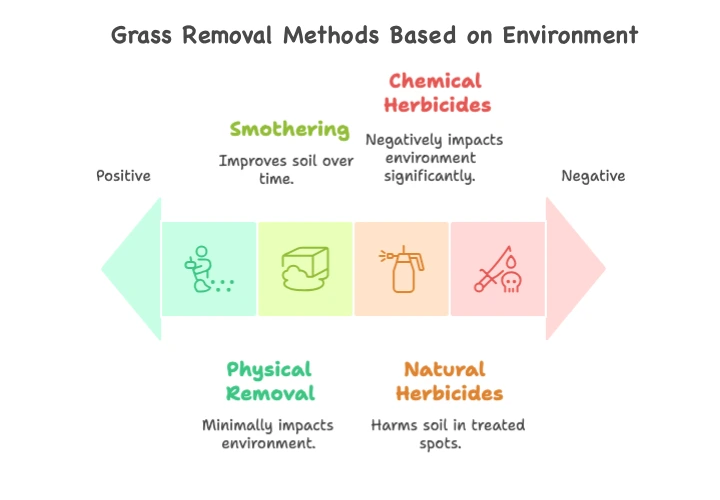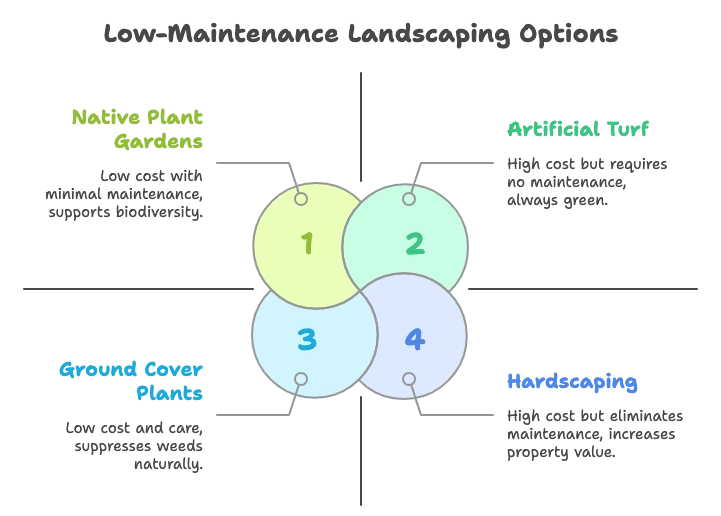Tired of spending every Saturday mowing, watering, and fighting weeds? You’re not alone. More homeowners are ditching traditional grass for beautiful, low-maintenance yard alternatives that give them their weekends back.
Whether you’re sick of the constant upkeep or just want a more sustainable yard, this guide will show you exactly how to transform your high-maintenance lawn into a gorgeous outdoor space that practically takes care of itself.
Why Homeowners Are Breaking Up with Grass
The Hidden Time Costs of Traditional Lawns
On average, Americans spend approximately 7.8 hours per year just mowing their lawns—that’s about 16 days over a lifetime dedicated solely to cutting grass. But mowing is just the beginning. When you factor in watering, fertilizing, weeding, and seasonal maintenance, many homeowners report spending 2-3 hours per week during peak growing seasons on lawn care.
That adds up to significant time that could be spent with family, pursuing hobbies, or simply relaxing in your outdoor space instead of constantly maintaining it.
The Water Crisis in Your Backyard
Here’s a sobering fact: landscape irrigation accounts for almost one-third of all residential water use in the United States, totaling more than 7 billion gallons per day according to the EPA. In arid regions like Denver, outdoor water use can reach up to 55% of total household consumption.
Even more concerning? Research shows that residents typically use 40% more water on their grass than most turf actually requires. Converting to water-efficient landscaping can reduce outdoor water use by 20-50%, translating to significant savings on utility bills.
Financial Reality Check
Professional lawn care services typically cost between $80-$180 per month, with full-service care reaching $150-$200 monthly. Annually, homeowners can expect to spend $1,000-$2,400 for comprehensive lawn maintenance, not including DIY costs for equipment, fertilizer, seeds, and increased water bills.
Even basic DIY lawn care averages $300 annually, with costs ranging from $100-$500 depending on lawn size and maintenance level. These ongoing expenses add up significantly over time.
Environmental Impact
Traditional lawns contribute to environmental challenges in multiple ways. Gas-powered lawn mowers are surprisingly polluting—operating a commercial gas-powered mower for just one hour produces as much ozone-forming emissions as driving a 2017 Toyota Camry from Trinidad, Colorado to Cheyenne, Wyoming.

Beyond air pollution, lawns offer little to no habitat for native species, contributing to declines in insect populations and other wildlife essential for ecosystem health. Chemical fertilizers and pesticides used on lawns can run off into local water systems, contributing to pollution and harming aquatic life.
Low-Maintenance Grass Removal Methods: Your Options
| Method | Time to Results | Physical Effort | Cost | Weed Barrier Type | Best For |
|---|---|---|---|---|---|
| Physical Removal | Immediate | High | Low-Medium | None needed | Small areas, immediate results |
| Smothering (Cardboard) | 2-6 months | Low | Low | Cardboard weed barrier | Large areas, soil improvement |
| Smothering (Landscape Fabric) | 2-4 months | Low | Medium | Heavy duty weed barrier | Permanent installations |
| Natural Herbicides | 1-2 weeks | Low | Low | Follow-up barrier recommended | Spot treatments only |
Physical Removal: Immediate Results
Using a flat-edge shovel or rented sod cutter provides instant gratification. This method works excellently for small to medium areas and allows removed sod to be reused elsewhere or composted. While labor-intensive, it requires no weed barrier since grass is completely removed.
Smothering: The Low-Maintenance Champion
The smothering method stands out as the most low-maintenance approach to grass removal, requiring minimal ongoing effort while delivering excellent long-term results.
Using Cardboard as Weed Barrier
Cardboard serves as an excellent biodegradable weed barrier that’s both cost-effective and environmentally friendly. Many homeowners ask “is cardboard a good weed barrier?” The answer is absolutely yes—it effectively blocks sunlight while decomposing to improve soil quality over time.
How to use cardboard as weed barrier:
- Remove all tape, staples, and glossy labels from cardboard
- Overlap sheets by 6 inches to prevent gaps
- Water thoroughly to help cardboard conform to ground
- Cover with 2-3 inches of mulch or soil

Landscape Fabric for Permanent Solutions
For areas destined for hardscaping or permanent installations, heavy duty weed barrier or commercial grade weed barrier provides longer-lasting suppression. These synthetic options work well under gravel, stone, or decorative rock installations.
Installation tips:
- Choose landscape weed barrier rated for your specific application
- Secure edges with landscape pins every 2-3 feet
- Overlap seams by 6 inches minimum
- Cut X-shaped slits for existing plants you want to keep
Natural Solutions: Proceed with Caution
While vinegar and salt solutions avoid synthetic chemicals, they often only kill top growth without eliminating roots, leading to regrowth. More importantly, these solutions can harm soil health—vinegar’s high acidity alters soil pH, while salt concentrations can be toxic to beneficial soil organisms. If using natural herbicides, plan to install a garden weed barrier afterward to prevent regrowth.

Low-Maintenance Alternatives: Find Your Perfect Match
Ground Cover Plants: Living Carpets That Care for Themselves
“The clear benefit of using ground covers instead of grass is less of everything—less water, less fertilizer, less pesticides and less mowing,” notes landscaping expert advice. These hardy plants spread naturally to form dense carpets that suppress weeds and require minimal care once established.
Best Low-Maintenance Options:
- Creeping Thyme: Fragrant, drought-tolerant, produces small flowers that attract pollinators
- Ajuga (Bugleweed): Thrives in shade, features attractive purple flower spikes
- Microclover: Stays naturally short, fixes nitrogen in soil, tolerates moderate foot traffic
- Creeping Jenny: Fast-spreading with bright chartreuse leaves, excellent for problem areas
- Moss: Perfect for shady, moist areas where grass struggles
Installation with Weed Barriers:
For best results, install cardboard weed barrier before planting ground covers. This prevents existing grass from competing with new plants while they establish.
Practical Considerations:
- Cost: $2-8 per square foot
- Maintenance: Virtually none after establishment
- Establishment Time: 1-2 growing seasons for full coverage
- Traffic Tolerance: Most handle light to moderate walking
Native Plant Gardens: 60% Less Water, Zero Fertilizer
Native plant gardens are not only lower maintenance and cheaper than traditional lawns—they’re significantly better for the planet. Research shows native plants can use up to 60% less water than turfgrass while providing essential habitat for pollinators, birds, and local wildlife.
Unlike lawns that offer little ecological value, native gardens support biodiversity and require no fertilizers or pesticides once established.
Low-Maintenance Installation:
- Use cardboard weed barrier to suppress existing grass
- Add 2-3 inches of compost over cardboard
- Plant native species appropriate for your region
- Mulch around plants to retain moisture
Practical Considerations:
- Cost: $3-15 per plant (one-time investment)
- Maintenance: Minimal after year one—occasional pruning and weeding
- Water Use: 60% less than traditional turf
- Design Flexibility: Formal or naturalistic styles possible

Hardscaping: Zero-Maintenance Elegance
Hardscaping eliminates maintenance entirely while creating functional outdoor living spaces and can increase property value significantly.
Gravel and Stone Gardens
Decorative gravel, river rock, or decomposed granite creates clean, modern looks requiring virtually no upkeep.
Essential Installation Steps:
- Install best weed barrier fabric rated for your climate
- Choose landscape weed barrier appropriate for stone type
- Ensure proper drainage to prevent water pooling
- Select stones appropriate for intended use (avoid pea gravel for walkways)
Cost: $2-8 per square foot depending on stone type and weed barrier fabric quality
Patio and Walkway Systems
Pavers, flagstone, or concrete create permanent outdoor rooms perfect for furniture and entertaining.
Benefits:
- Instant usability for outdoor dining and relaxation
- Increases property value significantly
- No ongoing maintenance beyond occasional cleaning
- Suitable for all climates
Artificial Turf: High-Tech Grass Alternative
Modern artificial turf looks remarkably realistic and provides the visual appeal of grass without any maintenance requirements.
Low-Maintenance Advantages:
- Always green and perfectly manicured
- No watering, mowing, or fertilizing ever
- Excellent for high-traffic areas
- Pet-friendly options available
Installation Requirements:
- Heavy duty weed barrier prevents grass breakthrough
- Proper base preparation ensures longevity
- Professional installation recommended for best results
Considerations:
- Higher upfront cost ($5-20 per square foot)
- Can become hot in direct sunlight
- Best for consistently used areas
Specialty Low-Maintenance Alternatives
No-Mow Grass Mixes
These specially bred grass varieties stay under 7 inches tall and rarely require cutting, perfect for homeowners wanting grass appeal without weekly mowing.
Clover Lawns
Pure clover lawns stay naturally short, fix nitrogen in the soil, and create a soft, green surface while supporting beneficial insects. Install over cardboard weed barrier for best establishment results.

Choosing Your Low-Maintenance Solution
Match Method to Maintenance Goals
Ultra-Low Maintenance (annual care or less): Hardscaping, artificial turf
Minimal Maintenance (seasonal care): Native plants, ground covers, clover
Reduced Maintenance (monthly care): No-mow grass mixes
Climate and Condition Matching
Hot, Dry Climates: Xeriscaping with natives, gravel gardens, hardscaping
Wet Climates: Moss, moisture-loving natives, proper drainage systems
Shady Areas: Moss, ajuga, native woodland plants
High-Traffic Zones: Artificial turf, clover, durable ground covers
Pet Areas: Pet-safe artificial turf, clover, hardy ground covers
Budget Planning for Low-Maintenance Solutions
Budget-Friendly ($1-3/sq ft): Cardboard weed barrier with natives, microclover overseeding
Medium Investment ($3-8/sq ft): Ground covers, basic hardscaping with landscape weed barrier
Premium Solutions ($8-20/sq ft): Artificial turf, elaborate patios, commercial grade weed barrier systems
Step-by-Step Low-Maintenance Transformation
Phase 1: Planning for Minimal Upkeep (Weeks 1-2)
- Assess maintenance tolerance: Determine how much ongoing care you want
- Choose appropriate alternatives: Match solutions to your maintenance goals
- Plan weed barrier strategy: Decide between biodegradable or synthetic options
- Order materials: Include appropriate weed barrier fabric for your chosen method
Phase 2: Grass Removal with Proper Barriers (Weeks 3-4+)
- Mark removal areas: Start with highest maintenance sections
- Install weed barriers: Use cardboard weed barrier for organic solutions or heavy duty weed barrier for hardscaping
- Execute removal: Let smothering methods work or remove physically for immediate results
Phase 3: Low-Maintenance Installation (Week 5+)
- Prepare surfaces: Ensure proper base for chosen alternative
- Install chosen solution: Follow best practices for long-term, low-maintenance success
- Add protective elements: Mulch, edging, or additional barriers as needed
Phase 4: Establishment and Minimal Care (Months 2-12)
- Monitor establishment: Ensure alternatives are establishing properly
- Minimal intervention: Water new plants during first season only
- Enjoy freedom: Watch your low-maintenance paradise develop
Key Takeaways for Low-Maintenance Success
- Weed Barriers Matter: Proper weed barrier installation prevents future maintenance headaches
- Start Small: Test low-maintenance solutions in problem areas first
- Choose Appropriate Methods: Match maintenance level to your lifestyle goals
- Quality Installation: Proper setup reduces long-term maintenance needs
- Time Investment Upfront: Initial effort pays dividends in reduced ongoing work
- Climate Considerations: Select solutions suited to your local conditions
Frequently Asked Questions About Low-Maintenance Grass Alternatives
Q: Can you use cardboard as a weed barrier?
A: Absolutely! Cardboard makes an excellent biodegradable weed barrier that blocks grass and weeds while improving soil as it decomposes. It’s cost-effective, environmentally friendly, and perfect for areas where you plan to plant ground covers or native plants.
Q: How long does cardboard weed barrier last?
A: Cardboard weed barrier typically lasts 6-18 months, depending on climate and moisture levels. This timeframe is perfect for establishing new plants while the cardboard decomposes to enrich the soil.
Q: Do you have to remove grass before putting down weed barrier?
A: No, you don’t need to remove grass before installing weed barrier. Both cardboard weed barrier and synthetic options work effectively when placed directly over existing grass, which will die from lack of sunlight.
Q: What is the best weed barrier for different applications?
A: Cardboard weed barrier is best for organic gardens and areas with future plantings. Heavy duty weed barrier or commercial grade weed barrier work better under permanent hardscaping like gravel or stone.
Q: How many layers of cardboard for weed barrier do I need?
A: A single layer of cardboard is sufficient for most weed barrier applications. Focus on proper overlap (6 inches) rather than multiple layers to prevent gaps where weeds can emerge.
Q: Can you put weed barrier over grass for hardscaping?
A: Yes, you can install landscape weed barrier directly over grass for hardscaping projects. The grass will die underneath, and the barrier prevents future weed growth through your gravel or stone.
Q: How to install weed barrier for maximum effectiveness?
A: For cardboard weed barrier: remove tape/staples, overlap 6 inches, water thoroughly, cover with mulch. For synthetic landscape weed barrier: secure every 2-3 feet, overlap seams 6 inches, cut X-slits for desired plants.
Q: What’s the most low-maintenance grass alternative?
A: Hardscaping with proper weed barrier installation offers the lowest maintenance, requiring only occasional cleaning. Native plant gardens with cardboard weed barrier during establishment offer the best balance of beauty and minimal upkeep.
Making the Switch to Low-Maintenance Living
Replacing high-maintenance grass isn’t just about reducing work—it’s about creating outdoor spaces that serve your lifestyle while requiring minimal ongoing attention. Whether you choose the ecological richness of native plants established over cardboard weed barrier, the clean functionality of hardscaping with commercial grade weed barrier, or the comfort of ground covers, you’re investing in more free time and lower ongoing costs.
The key to successful low-maintenance landscaping lies in proper initial installation, especially choosing the right weed barrier for your specific application. This upfront investment in quality materials and techniques pays dividends in reduced future maintenance.
Start with your most problematic, high-maintenance areas and gradually expand your low-maintenance zones. With proper planning and the right weed barrier strategy, you can create a beautiful outdoor space that enhances your property value while giving you back your weekends.
Your future self—relaxing in a beautiful, low-maintenance yard while your neighbors struggle with weekly lawn care—will thank you for making the switch to smarter landscaping solutions.

